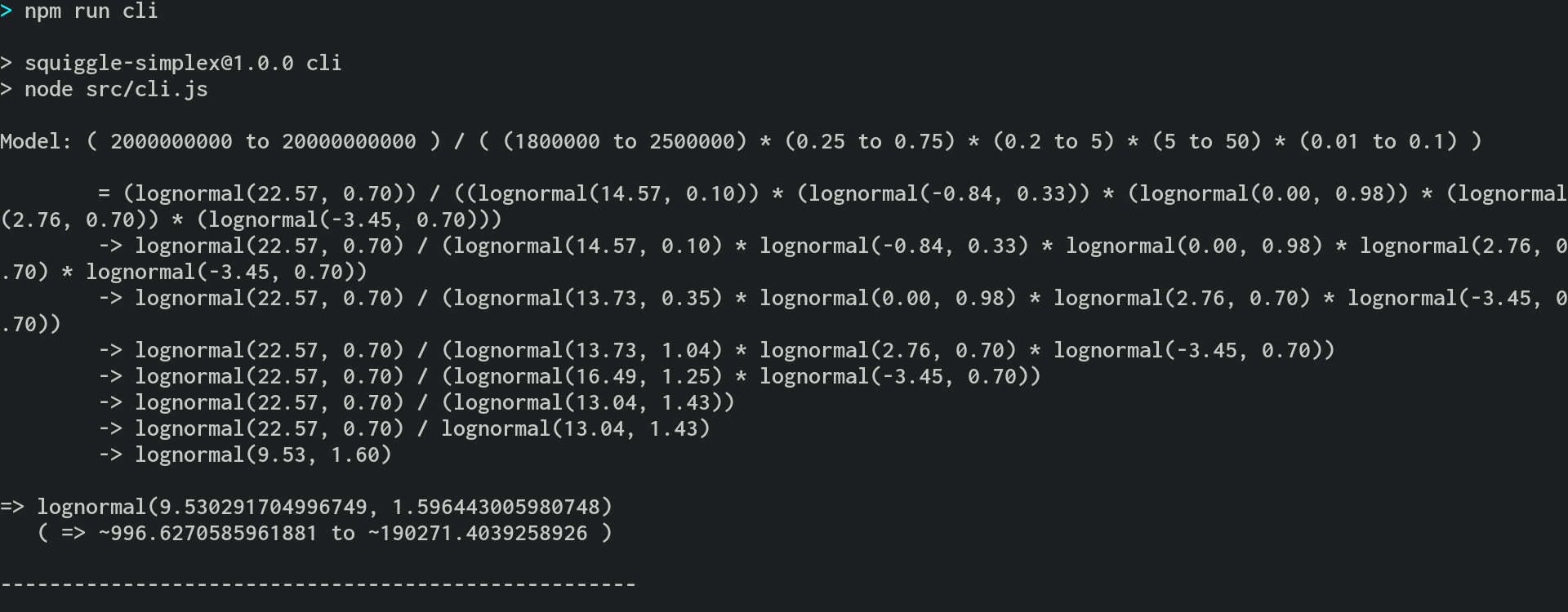4.8 KiB
Simple Squiggle
About
"Simple Squiggle" is a simple parser that manipulates multiplications and divisions between numbers and lognormal distributions. It uses an extremely restricted subset of Squiggle's syntax, and unlike it, the underlying code is not easily extensible.
It may be useful for testing correctness of limited features of the full Squiggle, or for sanity-checking the validity of some Squiggle models.
Built with
Getting started
Prerequisites
- npm
- nodejs
Installation
For command line usage
git clone https://github.com/quantified-uncertainty/simple-squiggle.git
cd simple-squiggle
## npm install
The last line is not necessary, since I'm saving node_packages in the repository.
For use inside another node program
npm install @forecasting/simple-squiggle
Usage
General usage
Consider a squiggle model which only uses lognormals:
initialPrisonPopulation = 1.8M to 2.5M # Data for 2022 prison population has not yet been published, though this estimate is perhaps too wide.
reductionInPrisonPopulation = 0.25 to 0.75
badnessOfPrisonInQALYs = 0.2 to 5 # 80% as good as being alive to 5 times worse than living is good
accelerationInYears = 5 to 50
probabilityOfSuccess = 0.01 to 0.1 # 1% to 10%.
estimateQALYs = leftTruncate(
initialPrisonPopulation *
reductionInPrisonPopulation *
badnessOfPrisonInQALYs *
accelerationInYears *
probabilityOfSuccess
, 0)
cost = 2B to 20B
costEffectivenessPerQALY = leftTruncate(cost / estimateQALYs, 0)
costEffectivenessPerQALY
It can be simplified to the following simple squiggle model:
( 2000000000 to 20000000000 ) / ( (1800000 to 2500000) * (0.25 to 0.75) * (0.2 to 5) * (5 to 50) * (0.01 to 0.1) )
I provide both an exportable library and a command line interface (cli). The cli can be run with npm run cli, which produces a prompt:
Command line
After cloning this repository through github (see installation section):
> npm run cli
Model:
After filling in the prompt
> npm run cli
Model: ( 2000000000 to 20000000000 ) / ( (1800000 to 2500000) * (0.25 to 0.75) * (0.2 to 5) * (5 to 50) * (0.01 to 0.1) )
the output looks as follows:
> npm run cli
Model: ( 2000000000 to 20000000000 ) / ( (1800000 to 2500000) * (0.25 to 0.75) * (0.2 to 5) * (5 to 50) * (0.01 to 0.1) )
= (lognormal(22.57, 0.70)) / ((lognormal(14.57, 0.10)) * (lognormal(-0.84, 0.33)) * (lognormal(0.00, 0.98)) * (lognormal(2.76, 0.70)) * (lognormal(-3.45, 0.70)))
-> lognormal(22.57, 0.70) / (lognormal(14.57, 0.10) * lognormal(-0.84, 0.33) * lognormal(0.00, 0.98) * lognormal(2.76, 0.70) * lognormal(-3.45, 0.70))
-> lognormal(22.57, 0.70) / (lognormal(13.73, 0.35) * lognormal(0.00, 0.98) * lognormal(2.76, 0.70) * lognormal(-3.45, 0.70))
-> lognormal(22.57, 0.70) / (lognormal(13.73, 1.04) * lognormal(2.76, 0.70) * lognormal(-3.45, 0.70))
-> lognormal(22.57, 0.70) / (lognormal(16.49, 1.25) * lognormal(-3.45, 0.70))
-> lognormal(22.57, 0.70) / (lognormal(13.04, 1.43))
-> lognormal(22.57, 0.70) / lognormal(13.04, 1.43)
-> lognormal(9.53, 1.60)
=> lognormal(9.530291704996749, 1.596443005980748)
( => ~996.6270585961881 to ~190271.4039258926 )
----------------------------------------------------
For ease of representation, the intermediary outputs are printed only to two decimal points. But this is just a display decision; the innards of the program work with the full set of decimals.
You can also run tests with npm run test
Exportable library
I also provide an exportable library. After installing it with npm (see installation section), you can call it with:
import { transformer } from "@forecasting/simple-squiggle";
// Helpers
let printer = (_) => null;
let getSimpleSquiggleOutput = (string) => transformer(string, printer);
// Model
let model = "( 2000000000 to 20000000000 ) / ( (1800000 to 2500000) * (0.25 to 0.75) * (0.2 to 5) * (5 to 50) * (0.01 to 0.1) )"
let result = getSimpleSquiggleOutput(model);
console.log(result); /* [
'lognormal(-0.3465735902799725, 1.1485521838283161)', // lognormal expression
'~0.10690936969938292 to ~4.676858552304103' // 90% confidence interval expression
] */
Roadmap
I consider this repository to be feature complete. As such, I may tinker with the code which wraps around the core logic, but I don't really intend to add further functionality.
- Make wrapper code less hacky
- Display final lognormal as a 90% confidence interval as well
License
Distributed under the MIT License

